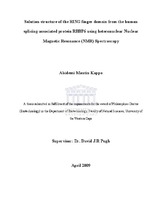| dc.description.abstract | Retinoblastoma-binding protein 6 (RBBP6) is a multi-domain human protein known to play a role in mRNA splicing, cell cycle control and apoptosis. The protein interacts with tumour suppressor proteins p53 and pRb and recent studies have shown that it plays a role in the ubiquitination of p53 by interacting with Hdm2, the human homologue of mouse double minute protein 2 (Mdm2), in which the RING finger domain plays an essential role. Recently, RBBP6 has been shown to ubiquitinate the mRNA-associated proteinYB-1 through its RING finger
domain, causing it to be degraded in the proteasome.RING (Really Interesting New Gene) fingers are small commonly-occurring domains of approximately 70 amino acids in length which coordinate two zinc ions in a cross-brace fashion.They are characterized by a conserved pattern of eight Cysteine or Histidine residues which are involved in coordinating the zinc ions. In terms of this conserved consensus, the RING finger from RBBP6 is expected to coordinate the zinc ions through eight Cysteine residues, making it a “C4C4” RING finger similar to those identified in transcription-associated proteins CNOT4(CCR4-NOT transcription complex, subunit 4) and p44 (interferon-induced protein 44). The amino acid sequence of the domain also shares many similarities with the U-box family of domains, which have an identical three-dimensional structure despite not requiring zinc ions in order to fold.
This thesis reports the bacterial expression of a fragment containing the RING finger domain from human RBBP6, and determination of its structure using heteronuclear Nuclear Magnetic Resonance (NMR) spectroscopy. Preliminary NMR analysis of the fragment revealed that the domain was folded, but that it was preceded by an unstructured region at the N-terminus. A shortened fragment was therefore expressed and used for structural studies. Isotope-enriched protein samples were generated by growing bacteria in minimal media supplemented with 15NNH4Cl and 13C-glucose and purified using a combination of glutathione agarose affinity chromatography, anion exchange and size exclusion chromatography. A complete set of heteronuclear NMR data was collected at 600 MHz from which almost complete assignment of the backbone, side-chain and aromatic resonances was achieved. By exchange of Zn2+ with 113Cd2+ we managed to confirm that the domain binds two Zn2+ ions, and confirm that they are coordinated in the expected cross-brace manner. Structural data in the form of 2-Dimensional
Nuclear Overhauser Enhancement Spectroscopy (2D-NOESY), 15N-separated NOESY and 13Cseparated NOESY spectra were recorded and used to determine the structure using restrained molecular dynamics on the Combined Assignment and Dynamics Algorithm for NMR Applications (CYANA) platform.As expected, the structure contains a triple-stranded β-sheet packing against an α-helix and two
zinc-stabilized loops as found in all RING fingers. However, it also contains a C-terminal helix which packs against an N-terminal loop which is similar to that found in many U-box domains.A search using the DALI server revealed that the structure is most similar to the U-box from CHIP (C-terminus of Hsp70-interacting protein), an E3 ligase that cooperates with Hsp70 to degrade unfolded proteins that cannot be refolded. Using NMR we showed that the domain dimerizes with a KD of approximately 200 Μm, which means that it is dimeric at the concentrations used for NMR structure determination. Chemical shift analysis showed the dimerization interface to be very similar to that identified in U-box domains found in C-terminus
of Hsp70 interacting proteins (CHIP).The structural similarities reported here between the RING finger from RBBP6 and the U-box family lead us to conclude that RBBP6 may, like CHIP, play a role in protein quality control. | en_US |

